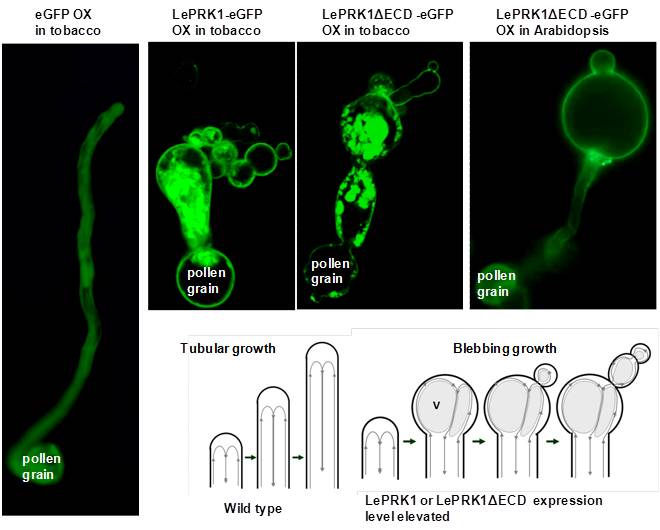Plant Cell:过表达番茄花粉受体激酶LePRK1导致花粉管生长转变为泡状模式

花粉管的极性管状生长对于显花植物双受精过程的顺利完成至关重要。番茄花粉受体激酶LePRK1是一个花粉特异表达且定位于花粉管细胞膜上的类受体激酶(RLK)。之前的研究表明,LePRK1能够和另外一个番茄花粉受体激酶LePRK2以及一个RopGEF蛋白——KPP (Kinase Partner Protein,激酶伴侣蛋白)相互作用,但LePRK1在番茄花粉管体内的生物学功能及其作用机制一直是未知的。
在最新发表的论文中,研究人员发现,当瞬时过表达全长LePRK1或缺失胞外结构域的LePRK1 (LePRK1ΔECD)后,番茄和烟草的花粉管顶端膨大并且产生额外的小泡,即花粉管从管状生长模式转变为泡状生长模式。同时,在拟南芥花粉管中稳定过表达缺失胞外结构域的LePRK1 (LePRK1ΔECD)时也发生了类似的生长模式的转变。
在之前的酵母双杂的研究结果中,研究人员发现了一个能够和KPP相互作用的肌动蛋白成束蛋白(actin bundling protein)PLIM2a。同时PLIM2a能够和KPP以一种Ca2+依赖的形式相互作用。在烟草花粉管中同时过表达LePRK1和PLIM2a时,PLIM2a能够抑制LePRK1单独过表达时的表型,即PLIM2a能够抑制LePRK1导致的泡状生长模式的发生。而同时过表达LePRK1,PLIM2a和KPP时,花粉管恢复了LePRK1单独过表达时的表型。
基于上述研究结果,科研人员推断,在花粉管中瞬时过表达LePRK1后,LePRK1通过KPP-PLIM2a调控花粉管肌动蛋白骨架的变化,从而实现了花粉管从管状生长模式到泡状生长模式的转变。这项研究揭示了花粉管细胞的一种潜在的能力,即通过单独过表达一个膜定位的分子LePRK1或LePRK1ΔECD,花粉管可以切换到另一种模式(即转变为泡状生长模式)达到花粉管生长前缘(leading edge)的延展。这一模式类似于已经报道的盘基网柄菌(Dictyostelium discoideum)和果蝇干细胞的泡状生长模式。
本研究得到了国家自然科学基金、科技部的经费支持,研究所公共技术服务中心植物细胞超微结构平台对本工作提供了重要技术支持。
原文摘要:
Cai-Ping Gui, Xin Dong, Hai-Kuan Liu, Wei-Jie Huang, Dong Zhang,Shu-Jie Wang, María Laura Barberini, Xiao-Yan Gao, Jorge Muschietti,Sheila McCormick, and Wei-Hua Tang
The tubular growth of a pollen tube cell is crucial for the sexual reproduction of flowering plants. LePRK1 is a pollen-specific and plasma membrane–localized receptor-like kinase from tomato(Solanum lycopersicum). LePRK1 interacts with another receptor, LePRK2, and with KINASE PARTNER PROTEIN (KPP), a Rop guanine nucleotide exchange factor. Here, we show that pollentubes overexpressing LePRK1 or a truncated LePRK1 lacking its extracellular domain (LePRK1ΔECD) have enlarged tips but also extend their leading edges by producing “blebs.” Coexpression ofLePRK1 and tomato PLIM2a, an actin bundling protein that interacts with KPP in a Ca2+-responsive manner, suppressedthese LePRK1 overexpression phenotypes, whereas pollen tubes coexpressing KPP, LePRK1, and PLIM2a resumed the blebbinggrowth mode. We conclude that overexpression of LePRK1 orLePRK1ΔECD rewires pollen tube growth to a blebbing mode, through KPP- and PLIM2a-mediated bundling of actin filaments from tip plasma membranes. Arabidopsis thaliana pollen tubes expressing LePRK1ΔECD also grew by blebbing. Our results exposed a hidden capability of the pollen tube cell: uponoverexpression of a single membrane-localized molecule,LePRK1 or LePRK1ΔECD, it can switch to an alternative mechanism for extension of the leading edge that is analogous tothe blebbing growth mode reported for Dictyostelium and forDrosophila melanogaster stem cells.
作者:中科院

